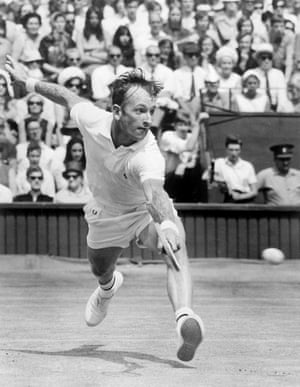
[ad_1]
Rod Laver recognises the apples/oranges element inherent in comparing records across eras, but the player acknowledged as the finest of his generation and voted as the best of the 20th century did something no other tennis great ever has: win the grand slam, twice. Repeat: all four majors in the same year. Twice.
The first, in 1962, was from a so-called amateur field already weakened by the defection to the professional ranks of the likes of Lew Hoad, Ken Rosewall and Pancho Gonzales. The second – and most significant – followed Laver’s own 21-slam exile while touring with the pros. The year, 1969, was the first full season of Open tennis. A towering achievement. With chronic elbow soreness. Without asterisks. A sporting Everest climbed.
Only the 1930s champion Don Budge had completed the feat before; no man has done it since. Jimmy Connors, Mats Wilander, Roger Federer, Rafael Nadal and Novak Djokovic have subsequently won three majors in a calendar year, while eight men own career grand slams. One of them, Andre Agassi, has described Laver’s accomplishments as “God-like’’. Amen to that.
My most recent interview with the diminutive Queenslander – in January, the day after his arrival for the Australian Open – was conducted in the Melbourne hotel from where there is a view across the Yarra to the physical monument that since 2000 has borne his name. Discussing Laver’s legacy, which humility insists he always does reluctantly, the 81 year old eventually mentions it: “My record. Just leave that out there. Whatever people think. Winning the grand slam certainly was a feather in my cap.’’
The second slam, in particular, given the full-strength fields once the pros had returned from the cold. “I think ’69 counts for more. A lot more,’’ John Newcombe told the Guardian, the seven-time slam winner revealing he had collected every draw sheet from those four majors, and once sat down with Laver to analyse them. The Australian Open in Brisbane, say, included an epic 90-game semi against Tony Roche.
“There was probably four or five times that he was in a lot of trouble, but he got out of every one,’’ says Newcombe. “It’s not easy to achieve that, and he did it, so you’ve got to rate it as a fantastic achievement. There was a lot of good players around at that time who had won grand slams, and Rod was the best of the best.’’
As to what made him so, Newcombe points to his fellow Australian’s remarkable ability to come up with the big shot at the right time. Indeed, hot was often scalding, and an example was a freakish crosscourt backhand winner when Newcombe had an early break in the third set of the 1969 Wimbledon final and, he estimates, 99% of the court covered. “I turned around and looked at him and just gave him the nod to say: ‘That was bloody great’.’’ Laver in four.

Rosewall, who lost the 1969 French Open final in what is acknowledged as one of Laver’s finest matches on clay, points to his great rival’s competitiveness and fearless, audacious shot-making, while applauding a remarkable, sustained ability to win matches in which he had seemed beaten. (Author’s note: Newcombe suggests Rosewall is being overly modest here, considering how little separated the pair over more than 150 contests, and nominating the 1968 French final and the two ground-breaking WCT finals the crazy-durable Sydneysider won.)
Fred Stolle recalls the man known as “Rocket” as an opponent who would never retreat; for whom having his serve broken was merely a signal to attack even more. Despite standing just 172cm, by utilising the power in his famously muscular left forearm, a fierce topspin backhand was a revolutionary point of difference in the days of so-called “low ball hitters” that included the other great Australians. In that grass-dominated era, Laver’s ability to take the ball on the rise was ahead of its time.
Physically fit and fast, Laver’s unflappable big-match temperament was borne out by results, notably that “absolutely phenomenal” record in 1962 and 69, according to Stolle. If his 11 career singles majors (including at least two of each, plus nine more in doubles and mixed and five Davis Cup triumphs) are dwarfed by the modern giants, his good friend Fred has little doubt that a player who lost more than five of his prime major-winning years – from 24 to almost 30 – to the gruelling pro ranks from which he returned a tougher, more complete player would have won many, many more.
Indeed, during Laver’s absence, Stolle reached eight slam finals, and lost to countryman Roy Emerson – fifth on the all-time list, asterisk required – in five of them. “I wouldn’t have won the two that I did win had I been playing against the pros of the time. Rod won 11 and didn’t play 21 and he was the best when he turned pro, and he was the best when he came back. So if we give him half of those, that puts him at 21.’’ (Note #2: Rosewall missed more than twice as many and still won eight. Perhaps even more noteworthy, and often overlooked, too.)
Yet just as we will never know, Laver – who played only a limited schedule from 1970 until his retirement in 1978 – has always maintained it has never mattered. Any regret is a small one: when he won that history-making match on the damp Forest Hills grass to reach the summit on September 9, 1969, an uncharacteristic celebration saw the expectant father jump the net before shaking hands with the vanquished Arthur Ashe.
Not an act Laver would repeat, Just like his achievement from over half-a-century ago is yet to be. Maybe it never will.
[ad_2]
Source link